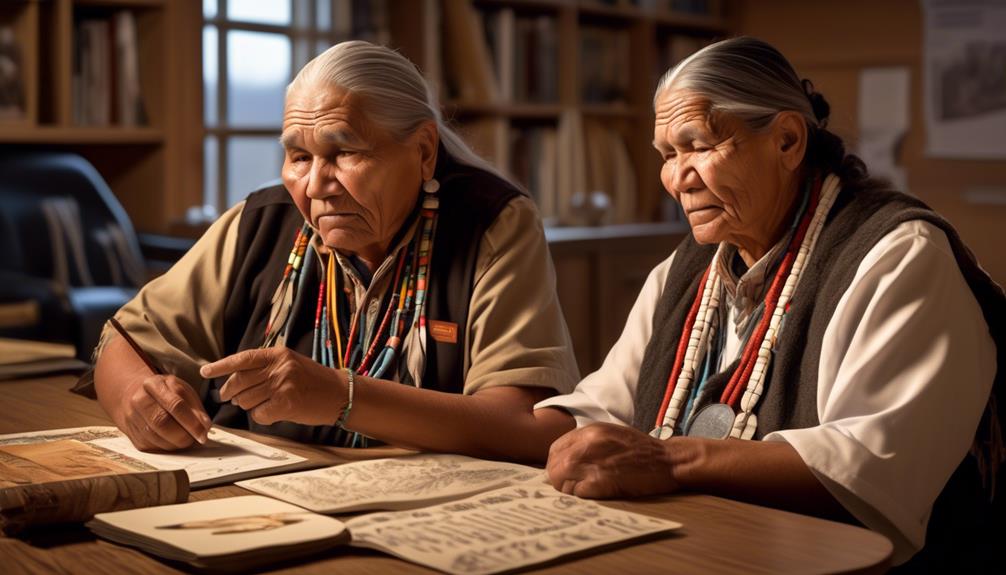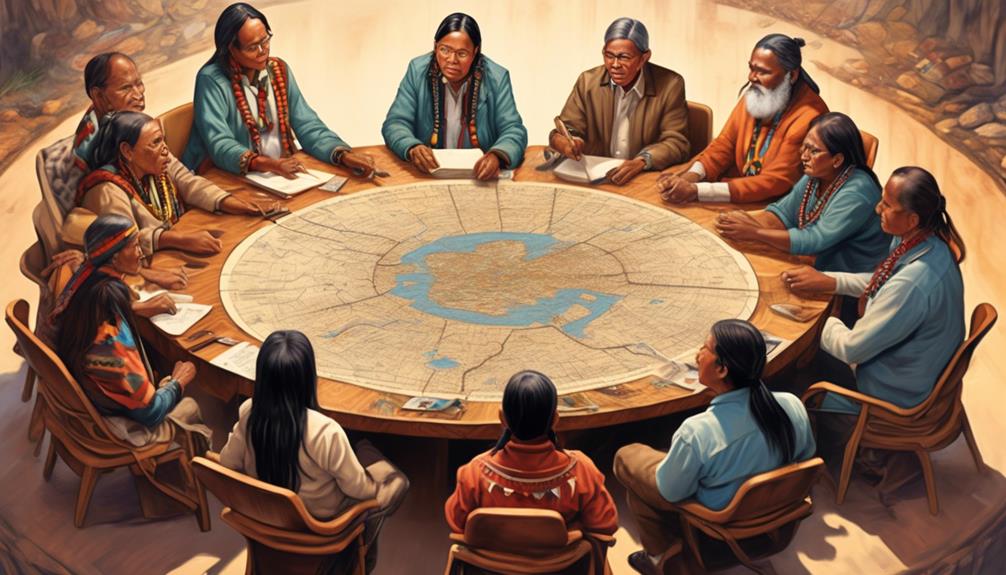In the intricate world of language policy, collaboration acts as the crucial connection between government officials and indigenous communities as they collaborate to preserve and revitalize native languages.
The symbiotic relationship between these two entities is crucial for the survival of indigenous languages, which are not only integral to cultural identity but also essential for maintaining intergenerational connections.
However, this partnership is not without its challenges, and the complexities of uniting diverse perspectives and priorities often lead to intricate negotiations.
As we navigate the complexities of collaborative language policy, it becomes evident that the convergence of government and indigenous communities holds the key to unlocking a future where linguistic diversity is not just preserved, but thrives.
Key Takeaways
- Collaborative partnerships have been instrumental in the production of Native language materials and resources.
- The National Indian Education Association supports and encourages collaborative efforts in Native language instruction.
- Ethical partnerships that align with the unique educational needs of Indigenous communities are crucial for success.
- Collaborative efforts have led to the development of tailored curricula, dictionaries, and technological apps to support language revitalization.
The Impact of Inequitable Language Planning
The repercussions of inequitable language planning resonate through the absence of Native language instruction in educational and community settings, impeding Native language revitalization. This absence is a significant barrier to the preservation and promotion of Indigenous languages, which aren't only vital components of cultural identity but also crucial for the overall well-being of Indigenous communities.
Inequitable language planning has resulted in a scarcity of comprehensive language curriculums, as tribes and schools often lack the necessary resources and teacher training for Native language instruction. This situation perpetuates a cycle of language loss and diminishes the potential for intergenerational language transmission.
However, there's hope in collaborative efforts aimed at addressing these challenges. Partnerships between Tribal communities, schools, and organizations have led to the production of Native language materials and resources, marking a positive step towards language revitalization. The National Indian Education Association's support for collaborative efforts and ethical partnerships in Native language instruction aligns with the unique educational needs of Indigenous communities and the United Nations Declaration on the Rights of Indigenous Peoples (UNDRIP).
Ongoing Threats to Indigenous Cultural Heritage

As we confront the ongoing threats to Indigenous cultural heritage, it's imperative to recognize the impact of inequitable language planning on the preservation and transmission of traditional knowledge and practices. Indigenous languages are integral to Tribal nations, serving as a cornerstone of their histories, cultures, and traditions. However, in the United States, ongoing language loss poses a significant risk to Indigenous cultural heritage. The lack of comprehensive Native language programs in many Tribal communities and schools is a major contributing factor to this threat. It's essential to address the ongoing language decline attributed to settler colonization and its detrimental effects on Indigenous cultural heritage.
Collaborative efforts are crucial in combating these threats. Partnerships between Tribal communities, schools, and non-profit organizations have led to the development of curricula, dictionaries, and technological apps aimed at promoting Native language learning. These collaborative initiatives align with the United Nations Declaration on the Rights of Indigenous Peoples (UNDRIP) and play a vital role in addressing the unique educational needs of Indigenous communities.
While language revitalization efforts have seen success in languages such as Hebrew, Welsh, Māori, and Hawaiian, there's still much work to be done in the United States to ensure the preservation and revitalization of Indigenous languages for the sake of safeguarding Indigenous cultural heritage.
Language Reclamation for Community Capacity Building
Working together with Indigenous communities, we're committed to supporting language reclamation efforts for the purpose of building community capacity.
Native languages are intrinsic to Tribal nations, embodying their histories, cultures, and traditions. By prioritizing Native language instruction in educational and community settings, tribes and schools serving Indigenous students play a pivotal role in Native language revitalization. This approach not only promotes the learning and transmission of Native languages but also fosters cultural reclamation within Tribal communities.
Through collaborative efforts, there's been a notable increase in the level of Native language learning, indicating progress in language reclamation. Empowering community members to reclaim and revitalize their languages not only preserves their cultural heritage but also strengthens the fabric of their communities.
As we continue this journey alongside Indigenous Peoples, our focus remains on facilitating language reclamation initiatives that empower Tribal communities and contribute to their overall capacity building. Together, we strive to create sustainable pathways for language revitalization, recognizing the profound impact it has on the well-being and identity of Indigenous communities.
Immersive Anishinaabe Language Education Policy

Collaborating with Indigenous communities, we prioritize Native language instruction in educational and community settings as part of the Immersive Anishinaabe Language Education Policy. This policy is essential for the revitalization of our ancestral language and the empowerment of Indigenous students. Here's how we're making a difference:
- Resource Allocation: We work with Tribal communities, schools, and organizations to secure resources for developing comprehensive language instruction curriculums, ensuring that our students have access to quality educational materials.
- Teacher Training: Collaborative partnerships are crucial for providing teacher training, equipping educators with the necessary skills to effectively teach our minoritized language.
- Curriculum Development: Our collaborative efforts result in the production of curricula, dictionaries, and teaching materials, tailored to the needs and cultural context of our Indigenous communities.
- Advocacy and Support: We align with the United Nations Declaration on the Rights of Indigenous Peoples and support Tribal sovereignty, advocating for increased Native language learning and revitalization.
Strength-Based Community-Based Language Planning
The implementation of Strength-Based Community-Based Language Planning requires acknowledging and leveraging the assets, strengths, and resources present within Indigenous communities. This approach unites communities, educational institutions, and non-profit organizations to revitalize and maintain the languages of American Indians and other indigenous communities.
By prioritizing the involvement of indigenous communities in decision-making processes for language policy development, it aligns with the principles of equity and social justice. The United Nations also emphasizes the significance of respecting and supporting the cultural and linguistic autonomy of indigenous communities in language revitalization efforts.
This collaborative effort recognizes the transformative potential to address the complex dynamics of language planning and policy in indigenous contexts. By focusing on the strengths and resources within these communities, this approach fosters a sense of unity and empowerment, allowing indigenous communities to take ownership of their language revitalization initiatives.
It's crucial to continue supporting and promoting strength-based community-based language planning to ensure the preservation of indigenous languages for generations to come.
Frequently Asked Questions
What Is an Example of Language Revitalization?
Community involvement is crucial for language revitalization. Our educational programs promote cultural preservation through technology integration and linguistic diversity.
We prioritize intergenerational transmission by collaborating with Indigenous communities, schools, and non-profit organizations. Together, we develop Native language materials and support bottom-up, community-based language planning, like the TEK-nology pilot project.
These efforts empower our communities to reclaim, preserve, and pass on our traditional languages for future generations.
How Can We Protect the Rights of Indigenous People?
We protect the rights of indigenous people through collaborative efforts, government collaboration, and community empowerment.
Indigenous representation and cultural preservation are vital for linguistic diversity. By working together, we ensure the protection of rights and promote the unique educational needs of indigenous communities.
This fosters a sense of belonging and empowerment, allowing indigenous people to thrive and preserve their rich cultural heritage.
What Are the Three Main Products Output of a Language Documentation Project?
In language documentation projects, the three main products output are language grammars, dictionaries, and annotated texts. These products are crucial for cultural preservation, community engagement, and linguistic analysis.
They serve as valuable resources for language learners and researchers, providing insight into the vocabulary, structure, and usage of the language. Additionally, audio and video recordings are created, contributing to digital archiving and collaborative research efforts.
What Are the Benefits of Language Documentation?
Documenting languages brings many benefits, including preservation of cultural heritage, linguistic diversity, and community empowerment. It also supports intergenerational knowledge transmission. These efforts are vital for sustaining our rich linguistic and cultural tapestry.
Through collaboration, we can ensure that the voices and stories of Indigenous communities are heard and celebrated. Language documentation not only enriches our understanding of the world but also honors the unique contributions of each community.
Conclusion
In conclusion, collaborative efforts in language policy are essential for uniting government and indigenous communities in preserving and revitalizing native languages.
These efforts are crucial for the preservation of indigenous cultural heritage, the development of resources for language instruction, and the promotion of native language learning.
By working together, we can ensure that the unique educational needs of indigenous communities are met and that their languages continue to thrive for generations to come.
Talise is a talented writer and an expert in her field. Her unique perspective and insights enrich our content with depth and authenticity. With a wealth of knowledge and a strong connection to the subjects she writes about, Talise crafts engaging and informative articles that resonate with our readers. Her dedication to bringing Indigenous culture and wisdom to light is truly commendable.










